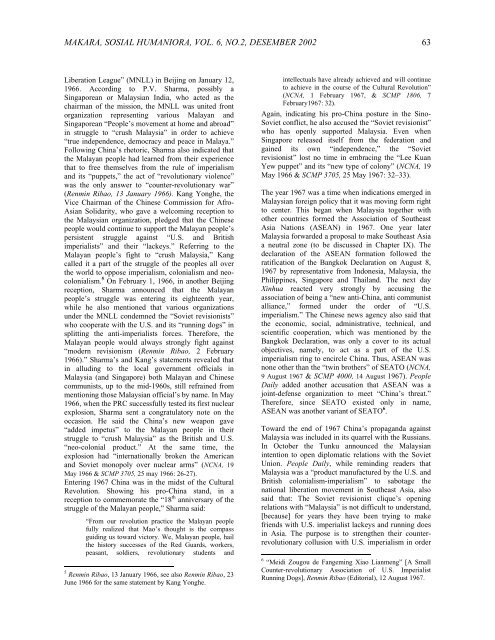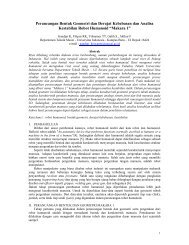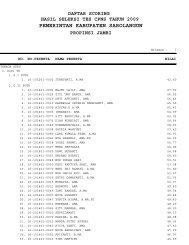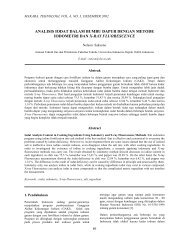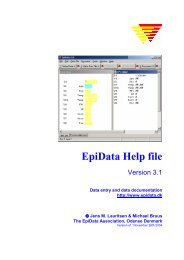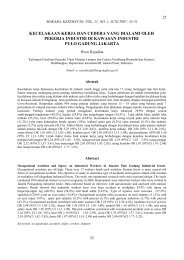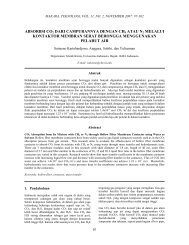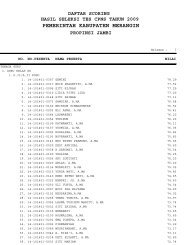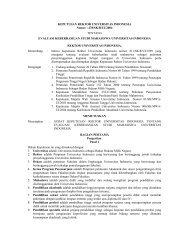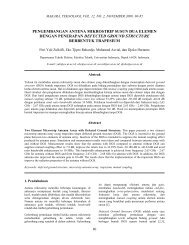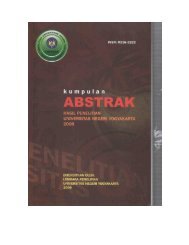“crush malaysia” campaign - Repository UI - Universitas Indonesia
“crush malaysia” campaign - Repository UI - Universitas Indonesia
“crush malaysia” campaign - Repository UI - Universitas Indonesia
Create successful ePaper yourself
Turn your PDF publications into a flip-book with our unique Google optimized e-Paper software.
MAKARA, SOSIAL HUMANIORA, VOL. 6, NO.2, DESEMBER 2002 63<br />
Liberation League” (MNLL) in Beijing on January 12,<br />
1966. According to P.V. Sharma, possibly a<br />
Singaporean or Malaysian India, who acted as the<br />
chairman of the mission, the MNLL was united front<br />
organization representing various Malayan and<br />
Singaporean “People’s movement at home and abroad”<br />
in struggle to <strong>“crush</strong> Malaysia” in order to achieve<br />
“true independence, democracy and peace in Malaya.”<br />
Following China’s rhetoric, Sharma also indicated that<br />
the Malayan people had learned from their experience<br />
that to free themselves from the rule of imperialism<br />
and its “puppets,” the act of “revolutionary violence”<br />
was the only answer to “counter-revolutionary war”<br />
(Renmin Ribao, 13 January 1966). Kang Yonghe, the<br />
Vice Chairman of the Chinese Commission for Afro-<br />
Asian Solidarity, who gave a welcoming reception to<br />
the Malaysian organization, pledged that the Chinese<br />
people would continue to support the Malayan people’s<br />
persistent struggle against “U.S. and British<br />
imperialists” and their “lackeys.” Referring to the<br />
Malayan people’s fight to <strong>“crush</strong> Malaysia,” Kang<br />
called it a part of the struggle of the peoples all over<br />
the world to oppose imperialism, colonialism and neocolonialism.<br />
5 On February 1, 1966, in another Beijing<br />
reception, Sharma announced that the Malayan<br />
people’s struggle was entering its eighteenth year,<br />
while he also mentioned that various organizations<br />
under the MNLL condemned the “Soviet revisionists”<br />
who cooperate with the U.S. and its “running dogs” in<br />
splitting the anti-imperialists forces. Therefore, the<br />
Malayan people would always strongly fight against<br />
“modern revisionism (Renmin Ribao, 2 February<br />
1966).” Sharma’s and Kang’s statements revealed that<br />
in alluding to the local government officials in<br />
Malaysia (and Singapore) both Malayan and Chinese<br />
communists, up to the mid-1960s, still refrained from<br />
mentioning those Malaysian official’s by name. In May<br />
1966, when the PRC successfully tested its first nuclear<br />
explosion, Sharma sent a congratulatory note on the<br />
occasion. He said the China’s new weapon gave<br />
“added impetus” to the Malayan people in their<br />
struggle to <strong>“crush</strong> Malaysia” as the British and U.S.<br />
“neo-colonial product.” At the same time, the<br />
explosion had “internationally broken the American<br />
and Soviet monopoly over nuclear arms” (NCNA, 19<br />
May 1966 & SCMP 3705, 25 may 1966: 26-27).<br />
Entering 1967 China was in the midst of the Cultural<br />
Revolution. Showing his pro-China stand, in a<br />
reception to commemorate the “18 th anniversary of the<br />
struggle of the Malayan people,” Sharma said:<br />
“From our revolution practice the Malayan people<br />
fully realized that Mao’s thought is the compass<br />
guiding us toward victory. We, Malayan people, hail<br />
the history successes of the Red Guards, workers,<br />
peasant, soldiers, revolutionary students and<br />
5 Renmin Ribao, 13 January 1966, see also Renmin Ribao, 23<br />
June 1966 for the same statement by Kang Yonghe.<br />
intellectuals have already achieved and will continue<br />
to achieve in the course of the Cultural Revolution”<br />
(NCNA, 1 February 1967, & SCMP 1806, 7<br />
February1967: 32).<br />
Again, indicating his pro-China posture in the Sino-<br />
Soviet conflict, he also accused the “Soviet revisionist”<br />
who has openly supported Malaysia. Even when<br />
Singapore released itself from the federation and<br />
gained its own “independence,” the “Soviet<br />
revisionist” lost no time in embracing the “Lee Kuan<br />
Yew puppet” and its “new type of colony” (NCNA, 19<br />
May 1966 & SCMP 3705, 25 May 1967: 32–33).<br />
The year 1967 was a time when indications emerged in<br />
Malaysian foreign policy that it was moving form right<br />
to center. This began when Malaysia together with<br />
other countries formed the Association of Southeast<br />
Asia Nations (ASEAN) in 1967. One year later<br />
Malaysia forwarded a proposal to make Southeast Asia<br />
a neutral zone (to be discussed in Chapter IX). The<br />
declaration of the ASEAN formation followed the<br />
ratification of the Bangkok Declaration on August 8,<br />
1967 by representative from <strong>Indonesia</strong>, Malaysia, the<br />
Philippines, Singapore and Thailand. The next day<br />
Xinhua reacted very strongly by accusing the<br />
association of being a “new anti-China, anti communist<br />
alliance,” formed under the order of “U.S.<br />
imperialism.” The Chinese news agency also said that<br />
the economic, social, administrative, technical, and<br />
scientific cooperation, which was mentioned by the<br />
Bangkok Declaration, was only a cover to its actual<br />
objectives, namely, to act as a part of the U.S.<br />
imperialism ring to encircle China. Thus, ASEAN was<br />
none other than the “twin brothers” of SEATO (NCNA,<br />
9 August 1967 & SCMP 4000, 14 August 1967). People<br />
Daily added another accusation that ASEAN was a<br />
joint-defense organization to meet “China’s threat.”<br />
Therefore, since SEATO existed only in name,<br />
ASEAN was another variant of SEATO 6 .<br />
Toward the end of 1967 China’s propaganda against<br />
Malaysia was included in its quarrel with the Russians.<br />
In October the Tunku announced the Malaysian<br />
intention to open diplomatic relations with the Soviet<br />
Union. People Daily, while reminding readers that<br />
Malaysia was a “product manufactured by the U.S. and<br />
British colonialism-imperialism” to sabotage the<br />
national liberation movement in Southeast Asia, also<br />
said that: The Soviet revisionist clique’s opening<br />
relations with “Malaysia” is not difficult to understand,<br />
[because] for years they have been trying to make<br />
friends with U.S. imperialist lackeys and running does<br />
in Asia. The purpose is to strengthen their counterrevolutionary<br />
collusion with U.S. imperialism in order<br />
6 “Meidi Zougou de Fangeming Xiao Lianmeng” [A Small<br />
Counter-revolutionary Association of U.S. Imperialist<br />
Running Dogs], Renmin Ribao (Editorial), 12 August 1967.


